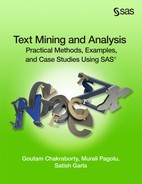Chapter 1 Introduction to Text Analytics
Text Mining Using SAS Text Miner
Enhancing Predictive Models Using Exploratory Text Mining
Overview of Text Analytics
Text analytics helps analysts extract meanings, patterns, and structure hidden in unstructured textual data. The information age has led to the development of a wide variety of tools and infrastructure to capture and store massive amounts of textual data. In a 2009 report, the International Data Corporation (IDC) estimated that approximately 80% percent of the data in an organization is text based. It is not practical for any individual (or group of individuals) to process huge textual data and extract meanings, sentiments, or patterns out of the data. A paper written by Hans Peter Luhn, titled “The Automatic Creation of Literature Abstracts,” is perhaps one of the earliest research projects conducted on text analytics. Luhn writes about applying machine methods to automatically generate an abstract for a document. In a traditional sense, the term “text mining” is used for automated machine learning and statistical methods that encompass a bag-of-words approach. This approach is typically used to examine content collections versus assessing individual documents. Over time, the term “text analytics” has evolved to encompass a loosely integrated framework by borrowing techniques from data mining, machine learning, natural language processing (NLP), information retrieval (IR), and knowledge management.
Text analytics applications are popular in the business environment. These applications produce some of the most innovative and deeply insightful results. Text analytics is being implemented in many industries. There are new types of applications every day. In recent years, text analytics has been heavily used for discovering trends
in textual data. Using social media data, text analytics has been used for crime prevention and fraud detection. Hospitals are using text analytics to improve patient outcomes and provide better care. Scientists in the pharmaceutical industry are to mine biomedical literature to discover new drugs.
Text analytics incorporates tools and techniques that are used to derive insights from unstructured data. These techniques can be broadly classified as the following:
• information retrieval
• exploratory analysis
• concept extraction
• summarization
• categorization
• sentiment analysis
• content management
• ontology management
In these techniques, exploratory analysis, summarization, and categorization are in the domain of text mining. Exploratory analysis includes techniques such as topic extraction, cluster analysis, etc. The term “text analytics” is somewhat synonymous with “text mining” (or “text data mining”). Text mining can be best conceptualized as a subset of text analytics that is focused on applying data mining techniques in the domain of textual information using NLP and machine learning. Text mining considers only syntax (the study of structural relationships between words). It does not deal with phonetics, pragmatics, and discourse.
Sentiment analysis can be treated as classification analysis. Therefore, it is considered predictive text mining. At a high level, the application areas of these techniques divide the text analytics market into two areas: search and descriptive and predictive analytics. (See Display 1.1.) Search includes numerous information retrieval techniques, whereas descriptive and predictive analytics include text mining and sentiment analysis.
Display 1.1: High-Level Classification of Text Analytics Market and Corresponding SAS Tools
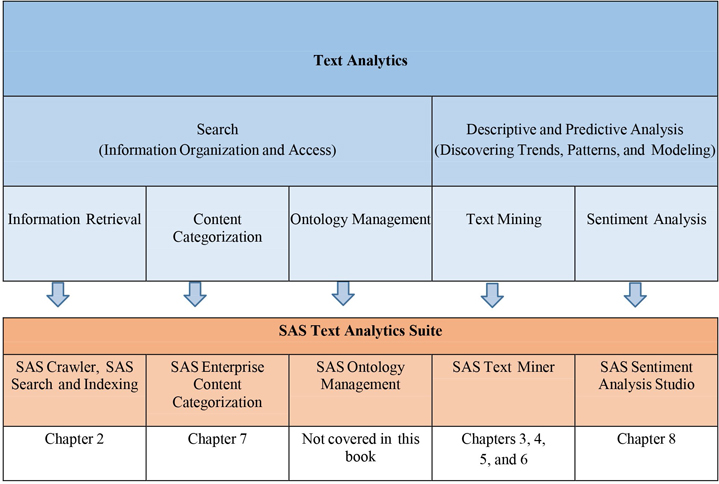
SAS has multiple tools to address a variety of text analytics techniques for a range of business applications. Display 1.1 shows the SAS tools that address different areas of text analytics. In a typical situation, you might need to use more than one tool for solving a text analytics problem. However, there is some overlap in the underlying features that some of these tools have to offer. Display 1.2 provides an integrated view of SAS Text Analytics tools. It shows, at a high level, how they are organized in terms of functionality and scope. SAS Crawler can extract content from the web, file systems, or feeds, and then send it as input to SAS Text Miner, SAS Sentiment Analysis Studio, or SAS Content Categorization. These tools are capable of sending content to the indexing server where information is indexed. The query server enables you to enter search queries and retrieve relevant information from the indexed content.
SAS Text Miner, SAS Sentiment Analysis Studio, and SAS Content Categorization form the core of the SAS Text Analytics tools arsenal for analyzing text data. NLP features such as tokenization, parts-of-speech recognition, stemming, noun group detection, and entity extraction are common among these tools. However, each of these tools has unique capabilities that differentiate them individually from the others. In the following section, the functionality and usefulness of these tools are explained in detail.
Display 1.2: SAS Text Analytics Tools: An Integrated Overview

The following paragraphs briefly describe each tool from the SAS Text Analytics suite as presented in Display 1.2:
• SAS Crawler, SAS Search and Indexing – Useful for extracting textual content from the web or from documents stored locally in an organized way. For example, you can download news articles from websites and use SAS Text Miner to conduct an exploratory analysis, such as extracting key topics or themes from the news articles. You can build indexes and submit queries on indexed documents through a dedicated query interface.
• SAS Ontology Management – Useful for integrating existing document repositories in enterprises and identifying relationships between them. This tool can help subject matter experts in a knowledge domain create ontologies and establish hierarchical relationships of semantic terms to enhance the process of search and retrieval on the document repositories.
Note: SAS Ontology Management is not discussed in this book because we primarily focus on areas where the majority of current business applications are relevant for textual data.
• SAS Content Categorization – Useful for classifying a document collection into a structured hierarchy of categories and subcategories called taxonomy. In addition to categorizing documents, it can be used to extract facts from them. For example, news articles can be classified into a predefined set of categories such as politics, sports, business, financial, etc. Factual information such as events, places, names of people, dates, monetary values, etc., can be easily retrieved using this tool.
• SAS Text Miner – Useful for extracting the underlying key topics or themes in textual documents. This tool offers the capability to group similar documents—called clusters—based on terms and their frequency of occurrence in the corpus of documents and within each document. It provides a feature called “concept linking” to explore the relationships between terms and their strength of association.
For example, textual transcripts from a customer call center can be fed into this tool to automatically cluster the transcripts. Each cluster has a higher likelihood of having similar problems reported by customers. The specifics of the problems can be understood by reviewing the descriptive terms explaining each of the clusters. A pictorial representation of these problems and the associated terms, events, or people can be viewed through concept linking, which shows how strongly an event can be related to a problem.
SAS Text Miner enables the user to define custom topics or themes. Documents can be scored based on the presence of the custom topics. In the presence of a target variable, supervised classification or prediction models can be built using SAS Text Miner. The predictions of a prediction model with numerical inputs can be improved using topics, clusters, or rules that can be extracted from textual comments using SAS Text Miner.
• SAS Sentiment Analysis – Useful for identifying the sentiment toward an entity in a document or the overall sentiment toward the entire document. An entity can be anything, such as a product, an attribute of a product, brand, person, group, or even an organization. The sentiment evaluated is classified as positive or negative or neutral or unclassified. If there are no terms associated with an entity or the entire document that reflect the sentiment, it is tagged “unclassified.”
Sentiment analysis is generally applied to a class of textual information such as customers’ reviews on products, brands, organizations, etc., or to responses to public events such as presidential elections.
This type of information is largely available on social media sites such as Facebook, Twitter, YouTube, etc.
Text Mining Using SAS Text Miner
A typical predictive data mining problem deals with data in numerical form. However, textual data is typically available only in a readable document form. Forms could be e-mails, user comments, corporate reports, news articles, web pages, etc. Text mining attempts to first derive a quantitative representation of documents. Once the text is transformed into a set of numbers that adequately capture the patterns in the textual data, any traditional statistical or forecasting model or data mining algorithm can be used on the numbers for generating insights or for predictive modeling.
A typical text mining project involves the following tasks:
1. Data Collection: The first step in any text mining research project is to collect the textual data required for analysis.
2. Text Parsing and Transformation: The next step is to extract, clean, and create a dictionary of words from the documents using NLP. This includes identifying sentences, determining parts of speech, and stemming words. This step involves parsing the extracted words to identify entities, removing stop words, and spell-checking. In addition to extracting words from documents, variables associated with the text such as date, author, gender, category, etc., are retrieved.
The most important task after parsing is text transformation. This step deals with the numerical representation of the text using linear algebra-based methods, such as latent semantic analysis (LSA), latent semantic indexing (LSI), and vector space model. This exercise results in the creation of a term- by-document matrix (a spreadsheet or flat-like numeric representation of textual data as shown in Table 1.1). The dimensions of the matrix are determined by the number of documents and the number of terms in the collection. This step might involve dimension reduction of the term-by-document matrix using singular value decomposition (SVD).
Consider a collection of three reviews (documents) of a book as provided below: Document 1: I am an avid fan of this sport book. I love this book.
Document 2: This book is a must for athletes and sportsmen. Document 3: This book tells how to command the sport.
Parsing this document collection generates the following term-by-document matrix in Table 1.1:
Table 1.1: Term-By-Document Matrix
| Term/Document | Document 1 | Document 2 | Document 3 |
| the | 0 | 0 | 1 |
| I | 2 | 0 | 0 |
| am | 1 | 0 | 0 |
| avid | 1 | 0 | 0 |
| fan | 1 | 0 | 0 |
| this | 2 | 1 | 1 |
| book | 2 | 1 | 1 |
| athletes | 0 | 1 | 0 |
| sportsmen | 0 | 1 | 0 |
| sport | 1 | 0 | 1 |
| command | 0 | 0 | 1 |
| tells | 0 | 0 | 1 |
| for | 0 | 1 | 0 |
| how | 0 | 0 | 1 |
| love | 1 | 0 | 0 |
| an | 1 | 0 | 0 |
| of | 1 | 0 | 0 |
| is | 0 | 1 | 0 |
| a | 0 | 1 | 0 |
| must | 0 | 1 | 0 |
| and | 0 | 1 | 0 |
| to | 0 | 0 | 1 |
3. Text Filtering: In a corpus of several thousands of documents, you will likely have many terms that are irrelevant to either differentiating documents from each other or to summarizing the documents. You will have to manually browse through the terms to eliminate irrelevant terms. This is often one of the most time-consuming and subjective tasks in all of the text mining steps. It requires a fair amount of subject matter knowledge (or domain expertise). In addition to term filtering, documents irrelevant to the analysis are searched using keywords. Documents are filtered if they do not contain some of the terms or filtered based on one of the other document variables such as date, category, etc. Term filtering or document filtering alters the term-by-document matrix. As shown in Table 1.1, the term- by-document matrix contains the frequency of the occurrence of the term in the document as the presence of the term in a document as the value for each cell. From this frequency matrix, a matrix is generated using various term-weighting techniques.
4. Text Mining: This step involves applying traditional data mining algorithms such as clustering, classification, association analysis, and link analysis. As shown in Display 1.3, text mining is an iterative process, which involves repeating the analysis using different settings and including or excluding terms for better results. The outcome of this step can be clusters of documents, lists of single-term or multi-term topics, or rules that answer a classification problem. Each of these steps is discussed in detail in Chapter 3 to Chapter 7.
Display 1.3: Text Mining Process Flow
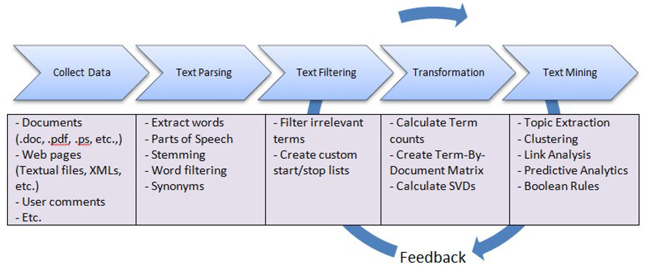
Information Retrieval
Information retrieval, commonly known as IR, is the study of searching and retrieving a subset of documents from a universe of document collections in response to a search query. The documents are often unstructured in nature and contain vast amounts of textual data. The documents retrieved should be relevant to the information needs of the user who performed the search query. Several applications of the IR process have evolved in the past decade. One of the most ubiquitously known is searching for information on the World Wide Web. There are many search engines such as Google, Bing, and Yahoo facilitating this process using a variety of advanced methods.
Most of the online digital libraries enable its users to search through their catalogs based on IR techniques. Many organizations enhance their websites with search capabilities to find documents, articles, and files of interest using keywords in the search queries. For example, the United States Patent and Trademark Office provides several ways of searching its database of patents and trademarks that it has made available to the public. In general, an IR system’s efficiency lies in its ability to match a user’s query with the most relevant documents in a corpus. To make the IR process more efficient, documents are required to be organized, metadata based on the original content of the documents. SAS Crawler is capable of pulling information from a wide variety of data sources. Documents are then processed by parsers to create various fields such as title, ID, URL, etc., which form the metadata of the documents. (See Display 1.4.) SAS Search and Indexing enables you to build indexes from these documents. Users can submit search queries on the indexes to retrieve information most relevant to the query terms. The metadata fields generated by the parsers can be used in the indexes to enable various types of functionality for querying.
Display 1.4: Overview of the IR Process with SAS Search and Indexing
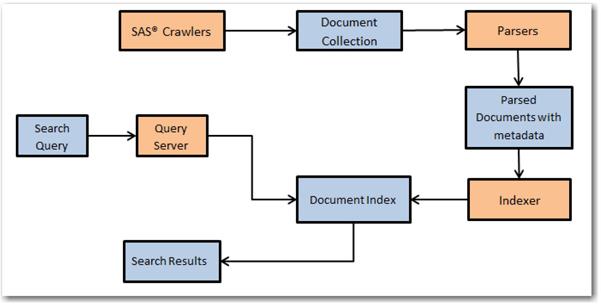
Document Classification
Document classification is the process of finding commonalities in the documents in a corpus and grouping them into predetermined labels (supervised learning) based on the topical themes exhibited by the documents. Similar to the IR process, document classification (or text categorization) is an important aspect of text analytics and has numerous applications.
Some of the common applications of document classification are e-mail forwarding and spam detection, call center routing, and news articles categorization. It is not necessary that documents be assigned to mutually exclusive categories. Any restrictive approach to do so might prove to be an inefficient way of representing the information. In reality, a document can exhibit multiple themes, and it might not be possible to restrict them to only one category. SAS Text Miner contains the text topic feature, which is capable of handling these situations. It assigns a document to more than one category if needed. (See Display 1.5.) Restricting documents to only one category might be difficult for large documents, which have a greater chance of containing multiple topics or features. Topics or categories can be either automatically generated by SAS Text Miner or predefined manually based on the knowledge of the document content.
In cases where a document should be restricted to only one category, text clustering is usually a better approach instead of extracting text topics. For example, an analyst could gain an understanding of a collection of classified ads when the clustering algorithm reveals the collection actually consists of categories such as Car Sales, Real Estate, and Employment Opportunities.
Display 1.5: Text Categorization Involving Multiple Categories per Document
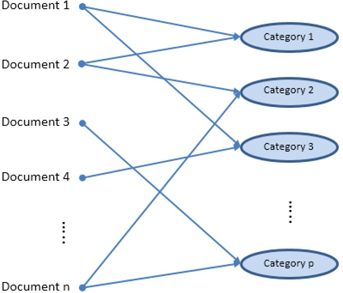
SAS Content Categorization helps automatically categorize multilingual content available in huge volumes that is acquired or generated or that exists in It has the capability to parse, analyze, and extract content such as entities, facts, and events in a classification hierarchy. Document classification can be achieved using either SAS Content Categorization or SAS Text Miner. However, there are some fundamental differences between these two tools. The text topic extraction feature in SAS Text Miner completely relies on the quantification of terms (frequency of occurrences) and the derived weights of the terms for each document using advanced statistical methods such as SVD.
On the other hand, SAS Content Categorization is broadly based on statistical and rule-based models. The statistical categorizer works similar to the text topic feature in SAS Text Miner. The statistical categorizer is used as a first step to automatically classify documents. Because you cannot really see the rules behind the classification methodology, it is called a black box model. In rule-based models, you can choose to use linguistic rules by listing the commonly occurring terms most relevant for a category. You can assign weights to these terms based on their importance. Boolean rule-based models use Boolean operators such as AND, OR, NOT, etc., to specify the conditions with which terms should occur within documents. This tool has additional custom-built operators to assess positional characteristics such as whether the distance between the two terms is within a distance of n terms, whether specific terms are found in a given sequence, etc. There is no limit on how complex these rules can be (for example, you can use nested Boolean rules).
Ontology Management
Ontology is a study about how entities can be grouped and related within a hierarchy. Entities can be subdivided based on distinctive and commonly occurring features. SAS Ontology Management enables you to create relationships between pre-existing taxonomies built for various silos or departments. The subject matter knowledge about the purpose and meaning can be used to create rules for building information search and retrieval systems. By identifying relationships in an evolutionary method and making the related content available, queries return relevant, comprehensive, and accurate answers. SAS Ontology Management offers the ability to build semantic repositories and manage company-wide thesauri and vocabularies and to build relationships between them.
To explain its application, consider the simple use case of an online media house named ABC. (The name was changed to maintain anonymity.) ABC uses SAS Ontology Management. ABC collects a lot of topics over a period of time. It stores each of these topics, along with metadata (properties), including links to images and textual descriptions. SAS Ontology Management helps ABC store relationships between the related topics. ABC regularly queries its ontology to generate a web page for each topic, showing the description, images, related topics, and other metadata that it might have selected to show. (See Display 1.6.) ABC uploads the information from SAS Ontology Management to SAS Content Categorization, and then tags news articles with topics that appear in the articles using rules that it’s created. All tagged articles are included in a list on the topic pages.
Display 1.6: Example Application of SAS Ontology Management from an Online Media Website

Information Extraction
In a relational database, data is stored in tables within rows and columns. A structured query on the database can help you retrieve the information required if the names of tables and columns are known. However, in the case of unstructured data, it is not easy to extract specific portions of information from the text because there is no fixed reference to identify the location of the data. Unstructured data can contain small fragments of information that might be of specific interest, based on the context of information and the purpose of analysis. Information extraction can be considered the process of extracting those fragments of data such as the names of people, organizations, places, addresses, dates, times, etc., from documents.
Information extraction might yield different results depending on the purpose of the process and the elements of the textual data. Elements of the textual data within the documents play a key role in defining the scope of information extraction. These elements are tokens, terms, and separators. A document consists of a set of tokens. A token can be considered a series of characters without any separators. A separator can be a special character, such as a blank space or a punctuation mark. A term can be a defined as a token with specific semantic purpose in a given language.
There are several types that can be performed on textual data.
• Token extraction
• Term extraction or term parsing
• Concept extraction
• Entity extraction
• Atomic fact extraction
• Complex fact extraction
Concept extraction involves identifying nouns and noun phrases. Entity extraction can be defined as the process of associating nouns with entities. For example, although the word “white” is a noun in English and represents a color, the occurrence of “Mr. White” in a document can be identified as a person, not a color. Similarly, the phrase “White House” can be attributed to a specific location (the official residence and principal workplace of the president of the United States), rather than as a description of the color of paint used for the exterior of a house. Atomic fact extraction is the process of retrieving fact-based information based on the association of nouns with verbs in the content (i.e., subjects with actions).
Clustering
Cluster analysis is a popular technique used by data analysts in numerous business applications. Clustering partitions records in a data set into groups so that the subjects within a group are similar and the subjects between the groups are dissimilar. The goal of cluster analysis is to derive clusters that have value with respect to the problem being addressed, but this goal is not always achieved. As a result, there are many competing clustering algorithms. The analyst often compares the quality of derived clusters, and then selects the method that produces the most useful groups. The clustering process arranges documents into nonoverlapping groups. (See Display 1.7.) Each document can fall into more than one topic area after classification. This is the key difference between clustering and the general text classification processes, although clustering provides a solution to text classification when groups must be mutually exclusive, as in the classified ads example.
In the context of text mining, clustering divides the document collection into mutually exclusive groups based on the presence of similar themes. In most business applications involving large amounts of textual data, it is often difficult to profile each cluster by manually reading and considering all of the text in a cluster. Instead, the theme of a cluster is identified using a set of descriptive terms that each cluster contains. This vector of terms represents the weights measuring how the document fits into each cluster. Themes help in better understanding the customer, concepts, or events. The number of clusters that are identified can be controlled by the analyst.
The algorithm can generate clusters based on the relative positioning of documents in the vector space. The cluster configuration is altered by a start and stop list.
Display 1.7: Text Clustering Process Assigning Each Document to Only One Cluster
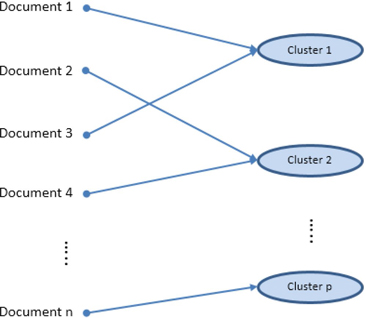
For example, consider the comments made by different patients about the best thing that they liked about the hospital that they visited.
1. Friendliness of the doctor and staff.
2. Service at the eye clinic was fast.
3. The doctor and other people were very, very friendly.
4. Waiting time has been excellent and staff has been very helpful.
5. The way the treatment was done.
6. No hassles in scheduling an appointment.
7. Speed of the service.
8. The way I was treated and my results.
9. No waiting time, results were returned fast, and great treatment.
The clustering results from text mining the comments come out similar to the ones shown in Table 1.2. Each cluster can be described by a set of terms, which reveal, to a certain extent, the theme of the cluster. This type of analysis helps businesses understand the collection as a whole, and it can assist in correctly classifying customers based on common topics in customer complaints or responses.
Table 1.2: Clustering Results from Text Mining
| Cluster No. | Comment | Key Words |
| 1 | 1, 3, 4 | doctor, staff, friendly, helpful |
| 2 | 5, 6, 8 | treatment, results, time, schedule |
| 3 | 2, 7 | service, clinic, fast |
The derivation of key words is accomplished using a weighting strategy, where words are assigned a weight using features of LSI. Text mining software products can differ in how the keywords are identified, resulting from different choices for competing weighting schemes.
SAS Text Miner uses two types of clustering algorithms: expectation maximization and hierarchical clustering. The result of cluster analysis is identifying cluster membership for each document in the collection. The exact nature of the two algorithms is discussed in detail in “Chapter 6 Clustering and Topic Extraction.”
Trend Analysis
In recent years, text mining has been used to discover trends in textual data. Given a set of documents with a time stamp, text mining can be used to identify trends of different topics that exist in the text. Trend analysis has been widely applied in tracking the trends in research from scientific literature. It has also been widely applied in summarizing events from news articles. In this type of analysis, a topic or theme is first defined using a set of words and phrases. Presence of the words across the documents over a period of time represents the trend for this topic. To effectively track the trends, it is very important to include all related terms to (or synonyms of) these words.
For example, text mining is used to predict the movements of stock prices based on news articles and corporate reports. Evangelopoulos and Woodfield (2009) show how movie themes trend over time, with male movies dominating the World War II years and female movies dominating the Age of Aquarius. As another example, mining social networks to identify trends is currently a very hot application area. Google Trends, a publicly available website, provides a facility to identify the trends in your favorite topics over a period of time. Social networking sites such as Twitter and blogs are great sources to identify trends. Here is a screenshot of the trend for the topic “text mining” from Google Trends. It is clearly evident that the growth in search traffic and online
posts for the term “text mining” peaked after 2007. This is when the popularity of text mining applications in the business world jump-started.
Display 1.8: Trend for the Term “text mining” from Google Trends
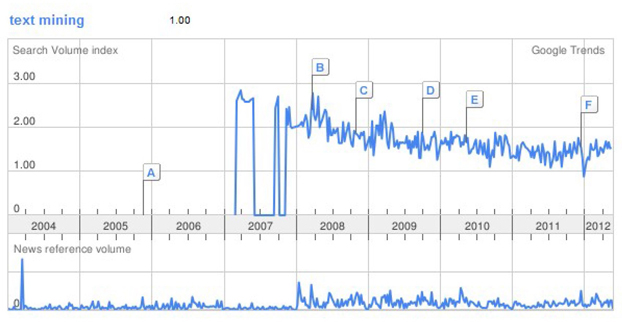
The concept linking functionality in SAS Text Miner helps in identifying co-occurring terms (themes), and it reveals the strength of association between terms. With temporal data, the occurrence of terms from concept links can be used to understand the trend (or pattern) of the theme across the time frame. Case Study 1 explains how this technique was applied to reveal the trend of different topics that have been presented at SAS Global Forum since 1976.
Enhancing Predictive Models Using Exploratory Text Mining
Although text mining customer responses can reveal valuable insights about a customer, plugging the results from text mining into a typical data mining model can often significantly improve the predictive power of the model. Organizations often want to use customer responses captured in the form of text via e-mails, customer survey questionnaires, and feedback on websites for building better predictive models. One way of doing this is to first apply text mining to reveal groups (or clusters) of customers with similar responses or feedback. This cluster membership information about each customer can then be used as an input variable to augment the data mining model. With this additional information, the accuracy of a predictive model can improve significantly.
For example, a large hospital conducted a post-treatment survey to identify the factors that influence a patient’s likelihood to recommend the hospital. By using the text mining results from the survey, the hospital was able to identify factors that showed an impact on patient satisfaction, which was not measured directly through the survey questions. Researchers observed a strong correlation between the theme of the cluster and the ratings given by the patient for the likelihood for the patient to recommend the hospital.
In a similar exercise, a large travel stop company observed significant improvement in predicting models by using customers’ textual responses and numerical responses from a survey. Display 1.9 shows an example receiver operating characteristic (ROC) curve of the models with and without textual comments. The ROC curve shows the performance of a binary classification model. The larger the area under the curve, the better the model performance. The square-dashed curve (green), which is an effect of including results from textual responses, has a larger area under the curve compared to the long-dashed-dotted curve (red), which represents the model with numerical inputs alone.
Display 1.9: ROC Chart of Models With and Without Textual Comments
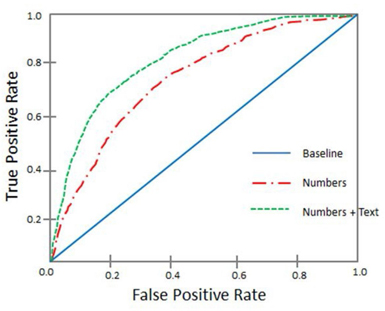
With the widespread adoption by consumers of social media, a lot of data about any prospect or customer is often available on the web. If businesses can cull and use this information, they can often generate better predictions of consumer behavior. For example, credit card companies can track customers’ posts on Twitter and other social media sites, and then use that information in credit scoring models. However, there are challenges to using text mining models and predictive models together because it can be difficult to get textual data for every member in the data mining model for the same time period.
Sentiment Analysis
The field of sentiment analysis deals with categorization (or classification) of opinions expressed in textual documents. Often these text units are classified into multiple categories such as positive, negative, or neutral, based on the valence of the opinion expressed in the units. Organizations frequently conduct surveys and focus group studies to track a customer’s perception of their products and services. However, these methods are time- consuming and expensive and cannot work in real time because the process of analyzing text is done manually by experts. Using sentiment analysis, an organization can identify and extract a customers’ attitude, sentiment, or emotions toward a product or service. This is a more advanced application of text analytics that uses NLP to capture the polarity of the text: positive, negative, neutral, or mixed. With the advent of social networking sites, organizations can capture enormous amounts of customers’ responses instantly. This gives real-time awareness to customer feedback and enables organizations to react fast. Sentiment analysis works on opinionated text while text mining is good for factual text. Sentiment analysis, in combination with other text analytics and data mining techniques, can reveal very valuable insights.
Sentiment analysis tools available from SAS offer a very comprehensive solution to capture, analyze, and report customer sentiments. The polarity of the document is measured at the overall document level and at the specific feature level.
Here is an example showing the results of a sentiment analysis on a customer’s review of a new TV brand:

In the previous text, green color represents positive tone, red color represents negative tone, and product features and model names are highlighted in blue and brown, respectively. In addition to extracting positive and negative sentiments, names of product models and their features are identified. This level of identification helps identify the sentiment of the overall document and tracks the sentiment at a product-feature level, including the characteristics and sub-attributes of features.
“Chapter 8 Sentiment Analysis” discusses sentiment analysis using SAS Sentiment Analysis Studio through an example of tracking sentiment in feedback comments from customers of a leading travel stop company.
Emerging Directions
Although the number of applications in text analytics has grown in recent years, there continues to be a high level of excitement about text analytics applications and research. For example, many of the papers presented at the Analytics 2011 Conference and SAS Global Forum 2013 were based on different areas of text analytics. In a way, the excitement about text analytics reminds us of the time when data mining and predictive modeling was taking off at business and academic conferences in the late 90s and early 2000s. The text analytics domain is constantly evolving with new techniques and new applications. Text analytics solutions are being adopted at the enterprise level and are being used to operationalize and integrate the voice of the customer into business processes and strategies. Many enterprise solution vendors are integrating some form of text analytics technology into their product line. This is evident from the rate of acquisitions in this industry. One of the key reasons that is fueling the growth of the field of text analytics is the increasing amount of unstructured data that is being generated on the web. It is expected that 90% of the digital content in the next 10 years will be unstructured data.
Companies across all industries are looking for solutions to handle the massive amounts of data, also popularly known as big data. Data is generated constantly from various sources such as transaction systems, social media interactions, clickstream data from the web, real-time data captured from sensors, geospatial information, and so on. As we have already pointed out, by some estimates, 80% of an organization’s current data is not numeric!
This means that the variety of data that constitutes big data is unstructured. This unstructured data comes in various formats: text, audio, video, images, and more. The constant streaming of data on social media outlets and websites means the velocity at which data is being generated is very high. The variety and the velocity of the data, together with the volume (the massive amounts) of the data organizations need to collect, manage, and process in real time, creates a challenging task. As a result, the three emerging applications for text analytics will likely address the following:
1. Handling big (text) data
2. Voice mining
3. Real-time text analytics
Handling Big (Text) Data
Based on the industry’s current estimations, unstructured data will occupy 90% of the data by volume in the entire digital space over the next decade. This prediction certainly adds a lot of pressure to IT departments, which already face challenges in terms of handling text data for analytical processes. With innovative hardware architecture, analytics application architecture, and data processing methodologies, high-performance computing technology can handle the complexity of big data. SAS High-Performance Text Mining helps you decrease the computational time required for processing and analyzing bulk volumes of text data significantly. It uses the combined power of multithreading, a distributed grid of computing resources, and in-memory processing. Using sophisticated implementation methodologies such as symmetric multiprocessing (SMP) and massively parallel processing (MPP), data is distributed across computing nodes. Instructions are allowed to execute separately on each node. The results from each node are combined to produce meaningful results. This is a cost-effective and highly scalable technology that addresses the challenges posed by the three Vs. (variety, velocity, and volume) of big data.
SAS High-Performance Text Mining consists of three components for processing very large unstructured data. These components are document parsing, term handling, and text processing control. In the document parsing component, several NLP techniques (such as parts-of-speech tagging, stemming, etc.) are applied to the input text to derive meaningful information. The term handling component accumulates (corrects misspelled terms using a synonyms list), filters (removes terms based on a start or stop list and term frequency), and assigns weights to terms. The text processing control component manages the intermediate results and the inputs and outputs generated by the document parsing and term handling components. It helps generate the term-by- document matrix in a condensed form. The term-by-document matrix is then summarized using the SVD method, which produces statistical representations of text documents. These SVD scores can be later included as numeric inputs to different types of models such as cluster or predictive models.
Voice Mining
Customer feedback is collected in many forms—text, audio, and video—and through various sources—surveys, e-mail, call center, social media, etc. Although the technology for analyzing videos is still under research and development, analyzing audio (also called voice mining) is gaining momentum. Call centers (or contact centers) predominantly use speech analytics to analyze the audio signal for information that can help improve call center effectiveness and efficiency. Speech analytics software is used to review, monitor, and categorize audio content. Some tools use phonetic index search techniques that automatically transform the audio signal into a sequence of phonemes (or sounds) for interpreting the audio signal and segmenting the feedback using trigger terms such as “cancel,” “renew,” “open account,” etc. Each segment is then analyzed by listening to each audio file manually, which is daunting, time-intensive, and nonpredictive. As a result, analytical systems that combine data mining methods and linguistics techniques are being developed to quickly determine what is most likely to happen next (such as a customer’s likelihood to cancel or close the account). In this type of analysis, metadata from each voice call, such as call length, emotion, stress detection, number of transfers, etc., that is captured by these systems can reveal valuable insights.
Real-Time Text Analytics
Another key emerging focus area that is being observed in text analytics technology development is real-time text analytics. Most of the applications of real-time text analytics are addressing data that is streaming continuously on social media. Monitoring public activity on social media is now a business necessity. For example, companies want to track topics about their brands that are trending on Twitter for real-time ad placement. They want to be informed instantly when their customers post something negative about their brand on the Internet. Less companies want to track news feeds and blog posts for financial reasons. Government agencies are relying on real-time text analytics that collect data from innumerate sources on the web to learn about and predict medical epidemics, terrorist attacks, and other criminal actions. However, real time can mean different things in different contexts. For companies involved in financial trading by tracking current events and news feeds, real time could mean milliseconds. For companies tracking customer satisfaction or monitoring brand reputation by collecting customer feedback, real time could mean hourly. For every business, it is of the utmost importance to react instantly before something undesirable occurs.
The future of text analytics will surely include the next generation of tools and techniques with increased usefulness for textual data collection, summarization, visualization, and modeling. Chances are these tools will become staples of the business intelligence (BI) suite of products in the future. Just as SAS Rapid Predictive Modeler today can be used by business analysts without any help from trained statisticians and modelers, so will be some of the future text analytics tools. Other futuristic trends and applications of text analytics are discussed by Berry and Kogan (2010).
Summary
Including textual data in data analysis has changed the analytics landscape over the last few decades. You have witnessed how traditional machine learning and statistical methods to learn unknown patterns in text data are now replaced with much more advanced methods combining NLP and linguistics. Text mining (based on a traditional bag-of-words approach) has evolved into a much broader area (called text analytics). Text analytics
is regarded as a loosely integrated set of tools and methods developed to retrieve, cleanse, extract, organize, analyze, and interpret information from a wide range of data sources. Several techniques have evolved, with each focused to answer a specific business problem based on textual data. Feature extraction, opinion mining, document classification, information extraction, indexing, searching, etc., are some of the techniques that we have dealt with in great detail in this chapter. Tools such as SAS Text Miner, SAS Sentiment Analysis Studio, SAS Content Categorization, SAS Crawler, and SAS Search and Indexing are mapped to various analysis methods. This information helps you distinguish and differentiate the specific functionalities and features that each of these tools has to offer while appreciating the fact that some of them share common features.
In the following chapters, we use SAS Text Analytics tools (except SAS Ontology Management, which is not discussed in this book) to address each methodology discussed in this chapter. Chapters are organized in a logical sequence to help you understand the end-to-end processes involved in a typical text analysis exercise. In Chapter 2, we introduce methods to extract information from various document sources using SAS Crawler. We show you how to deal with the painstaking tasks of cleansing, collecting, transforming, and organizing the unstructured text into a semi-structured format to feed that information into other SAS Text Analytics tools. As you progress through the chapters, you will get acquainted with SAS Text Analytics tools and methodologies that will help you adapt them at your organization.
References
Albright, R., Bieringer, A., Cox, J., and Zhao, Z. 2013. “Text Mine Your Big Data: What High Performance Really Means”. Cary, NC: SAS Institute Inc. Available at: http://www.sas.com/content/dam/SAS/en_us/doc/whitepaper1/text-mine-your-big-data-106554.pdf
Berry, M.W., and Kogan, J. Eds. 2010. Text Mining: Applications and Theory. Chichester, United Kingdom: John Wiley & Sons.
Dale, R., Moisl, H. and Somers, H. 2000. Handbook of Natural Language Processing. New York: Marcel Dekker.
Dorre, J. Gerstl, P., and Seiffert, R. 1999. “Text Mining: Finding Nuggets in Mountains of Textual Data”.
KDD-99: Proceedings of the Fifth ACM SIGKDD International Conference on Knowledge Discovery and Data Mining. San Diego, New York: Association for Computing Machinery, 398-401.
Evangelopoulos, N., and Woodfield, T. 2009. “Understanding Latent Semantics in Textual Data”. M2009 12th Annual Data Mining Conference, Las Vegas, NV.
Feldman, R. 2004. “Text Analytics: Theory and Practice”. ACM Thirteenth Conference on Information and Knowledge Management (CIKM) CIKM and Workshops 2004. Available at: http://web.archive.org/web/20041204224205/http://ir.iit.edu/cikm2004/tutorials.html
Grimes, S. 2007. “What’s Next for Text. Text Analytics Today and Tomorrow: Market, Technology, and Trends”. Text Analytics Summit 2007.
Halper, F.,Kaufman, M., and Kirsh, D. 2013. “Text Analytics: The Hurwitz Victory Index Report”. Hurwitz & Associates 2013. Available at: http://www.sas.com/news/analysts/Hurwitz_Victory_Index-TextAnalytics_SAS.PDF
H.P.Luhn. 1958. “The Automatic Creation of Literature Abstracts”. IBM Journal of Research and Development, 2(2):159-165.
Manning, C. D., and Schutze, H. 1999. Foundations of Statistical Natural Language Processing. Cambridge, Massachusetts: The MIT Press.
McNeill, F. and Pappas, L. 2011. “Text Analytics Goes Mobile”. Analytics Magazine, September/October 2011. Available at: http://www.analytics-magazine.org/septemberoctober-2011/403-text-analytics-goes-mobile
Mei, Q. and Zhai, C. 2005. “Discovering Evolutionary Theme Patterns from Text: An Exploration of Temporal Text Mining”. KDD 05: Proceedings of the Eleventh ACM SIGKDD International Conference on Knowledge Discovery in Data Mining, 198 – 207.
Miller, T. W, 2005. Data and Text Mining: A Business Applications Approach. Upper Saddle River, New Jersey: Pearson Prentice Hall.
Radovanovic, M. and Ivanovic, M. 2008. “Text Mining: Approaches and Applications”. Novi Sad Journal of Mathematics. Vol. 38: No. 3, 227-234.
Salton, G., Allan, J., Buckley C., and Singhal, A. 1994. “Automatic Analysis, Theme Generation, and Summarization of Machine-Readable Texts”. Science, 264.5164 (June 3): 1421-1426.
SAS® Ontology Management, Release 12.1. Cary, NC: SAS® Institute Inc.
Shaik, Z., Garla, S., Chakraborty, G. 2012. “SAS® since 1976: an Application of Text Mining to Reveal Trends”. Proceedings of the SAS Global Forum 2012 Conference. SAS Institute Inc., Cary, NC.
Text Analytics Using SAS® Text Miner. Course Notes. Cary, NC, SAS Institute. Inc. Course information: https://support.sas.com/edu/schedules.html?ctry=us&id=1224
Text Analytics Market Perspective. White Paper, Cary, NC: SAS Institute Inc. Available at: http://smteam.sas.com/xchanges/psx/platform%20sales%20xchange%20on%20demand%20%202007%20sessions/text%20analytics%20market%20perspective.doc
Wakefield, T. 2004. “A Perfect Storm is Brewing: Better Answers are Possible by Incorporating Unstructured Data Analysis Techniques.” DM Direct Newsletter, August 2004.
Weiss S, Indurkhya N, Zhang T, and Damerau F. 2005. Text Mining: Predictive Methods for Analyzing Unstructured Information. Springer-Verlag.
